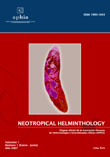MICROEPIDEMIOLOGICAL INVESTIGATION OF STRONGYLOIDES STERCORALIS IN INFECTED PATIENTS HOUSES WITH THE HUMAN IMMUNODEFICIENCY VIRUS (HIV)
DOI:
https://doi.org/10.24039/rnh2007111150Keywords:
Strongyloides stercoralis, Helminths, Allium fistolosum, Acquired Immunodeficiency Syndrome, Inmunossuppression, Environmental Pollution.Abstract
A possible association between intestinal parasite infection in immunocompromised patients with and the contamination their domiciliary environment may exist. Therefore, this correlation was studied through a study microepidemiologic by determining the presence of helminths and intestinal coccidian in samples obtaneid from the floor, water and vegetables of common and constant use in houses of patients with the Human Immunodeficiency Virus (HIV+, CD4 lymphocytes ≥ 200 mL, viral load ≈ 10 thousand). The samples were selected by random and systematized sampling. For the analysis of the floor the techniques of Cadwell-Cadwell, Hoffmann, Pons & Janer (HPJ) and modified Kinyoun (hot) were used whereas HPJ, Faust, and the filtration technique with propilethylene filter were used for water and vegetables samples. We found rhabditiform larves of Strongyloides stercoralis in Allium fistolosum (Chinese onion) cultivated in the vegetable garden of one of the 11 patient’s. Although this parasitic form is a non-infective stage for the human, it makes part of the biological cycle of S. stercoralis and it is fundamental for its multiplication and maintenance in the environment. This finding denotes the human ecological importance in the dynamics of the transmission of geohelminths, and alerts to necessity of instructing the population on measured prophylaxes and hygiene, especially to immunocompromised patients.
Downloads
Published
How to Cite
Issue
Section
License

This work is licensed under a Creative Commons Attribution-NonCommercial-NoDerivatives 4.0 International License.
OBJETO: El AUTOR-CEDENTE transfiere de manera TOTAL Y SIN LIMITACIÓN alguna al CESIONARIO los derechos patrimoniales que le corresponden sobre la (s) obra(s) tituladas: xxxxxxxxxxxxxxxx, por el tiempo que establezca la ley internacional. En virtud de lo anterior, se entiende que el CESIONARIO adquiere el derecho de reproducción en todas sus modalidades, incluso para inclusión audiovisual; el derecho de transformación o adaptación, comunicación pública, traducción, distribución y, en general, cualquier tipo de explotación que de las obras se pueda realizar por cualquier medio conocido o por conocer en el territorio nacional o internacional.
REMUNERACIÓN: La cesión de los derechos patrimoniales de autor que mediante este contrato se hace será a título gratuito.
CONDICIONES Y LEGITIMIDAD DE LOS DERECHOS: El AUTOR-CEDENTE garantiza que es propietario integral de los derechos de explotación de la(s) obra(s) y en consecuencia garantiza que puede contratar y transferir los derechos aquí cedidos sin ningún tipo de limitación por no tener ningún tipo de gravamen, limitación o disposición. En todo caso, responderá por cualquier reclamo que en materia de derecho de autor se pueda presentar, exonerando de cualquier responsabilidad al CESIONARIO.
LICENCIA DE ACCESO ABIERTO: El AUTOR-CEDENTE autoriza que manuscrito publicado en La Revista Neotropical Helminthology permanece disponible para su consulta pública en el sitio web https://www.neotropicalhelminthology.com/ y en los diferentes sistemas de indexación y bases de datos en las que la revista tiene visibilidad, bajo la licencia Creative Commons, en la modalidad Reconocimiento-No comercial- Sin Trabajos derivados –aprobada en Perú, y por lo tanto son de acceso abierto. De ahí que los autores dan, sin derecho a retribución económica, a la Asociación Peruana de Helmintología e Invertebrados Afines (APHIA), los derechos de autor para la edición y reproducción a través de diferentes medios de difusión.


 Numero 2 Volumen 19 - 2025 (versión Anticipada)
Numero 2 Volumen 19 - 2025 (versión Anticipada)














































